An Image Analysis of the Possible 1936-S Over 29 Mercury Dime (Long)
 TomB
Posts: 22,115 ✭✭✭✭✭
TomB
Posts: 22,115 ✭✭✭✭✭
Before I begin this lengthy post let me explain that I have always used my own website through Network Solutions to host my images, but Network Solutions is currently having an issue with website editing at the moment and I cannot add images to my site. They expect the software to be fixed by mid-week, but I went ahead and opened a Photobucket account in order to share these images at this time. In the future, when Network Solutions fixes their internal issue, I will change the URL for the images and again host them on my own website.
There has been some discussion and quite a bit of digging heels in the sand on the boards this past week regarding this possible overdate. To be upfront with all, I never thought I would be writing a thread about an overdate or possible overdate Mercury dime. In general, I find some overdates, doubled dies, die marriages and the like interesting while the majority do not move me one way or another. The overdates that have caught my attention are the 1805/4 DBH and 1817/3 CBH, the doubled dies would be the 1934 WQ DDO, 1955 Lincoln DDO and 1972 Lincoln DDO while the die marriages have more to do with early Federal coinage quirks than anything else. Regardless, I find myself here tonight writing about a possible overdate in the Mercury dime series.
The reason for this thread stems from the latest discussion of this coin here in combination with previous discussions in June, 2010 here and November, 2010 here. If these discussions had stayed on topic and not strayed into some hypothesizing as to personal motivations then I highly doubt I would be moved to write about this coin. After all, I have little interest in the Mercury dime series (aside from the coin as a type coin) and even less interest in most named die varieties.
In this thread, this coin has been approached as I would approach any scientific problem in any lab that I have had over the years, regardless of if the lab were in a hospital-based academic setting, a chemical quality control industrial setting, a research and development pharmaceutical setting or a biotech setting. I have attempted to go about identifying the problem or question, assessing what tools I have at my disposal, examining the data and then coming to likely conclusions. There is no doubt in my mind that whatever conclusion might be reached on my part that some will not agree. That is okay, but it helps if those who do not agree can point out the errors of my ways, can add more valid data or can give a plausible explanation that runs counter to this interpretation. In other words; I don’t have to be correct and, in fact, within science it is quite common for interpretations or likely possibilities to be wrong. Additionally, it is accepted practice for most data to be shared and for those who provide the data to explain why they made the choices that were made. Therefore, this thread might be even less reader-friendly than a typical thread that I might produce and for that I apologize, but hope all understand my goal.
In the June, 2010 thread, which was titled “Pick on this for me”, I admitted that I could not see a 1936/1929 or 36/29 overdate and at the same time offered that it might be a series of fortuitously placed die gouges. The explanations given to the contrary did not match what I thought likely or what I could see in images, but I was not too concerned about the coin. I felt comfortable questioning the coin given the title of the thread. The second thread had little input from me except when it was written that some who might not believe the 1936/1929 or 36/29 overdate explanation might be doing so out of some sort of ego driven reason. During that discussion I asked if another forum member, who owns multiple examples of this coin, would be willing to ship to me a high grade example for in-hand inspection and high quality photography. Of course, I would have returned the coin immediately after images were taken. This request was rejected outright and instead images were emailed to me, but the images were not very useful. I proceeded again to not think of the coin until the most recent thread and the statements by certain proponents of the overdate theory as to the motives of at least some of us who do not support the 1936/1929 or 36/29 idea. The most recent thread also asked for discussion, so again I felt freer to engage the topic.
My goals are to find the most likely reason(s) for the marks near the date on this coin as well as to reject anything that cannot be supported by evidence. Aside from that I do not care about the topic and if it turns out that the data at my disposal suggest a true 1936/1929 or 36/29 overdate then I will state my conclusions as such. In order to best interpret this coin I again mentioned that I had requested an in-hand inspection of the piece, but again the owner of the coin did not volunteer to go along with the offer. Please note that I cannot find too much fault in the refusal to ship the coin since even with Registered Mail there are losses from time-to-time and a loss of a dearly held coin is especially painful. However, the owner did supply the PCGS images of the coin and this is a wonderful thing to have for analysis. The PCGS images allow the following-
1) Examination of multiple examples of the same date/mintmark combination via the archived PCGS images held on the CoinFacts site.
2) Generally exceptional quality images.
3) Uniformity of images that greatly exceeds what would otherwise be available if images were taken from multiple sources.
4) Photography of the coin before encapsulation.
5) Large file sizes that allow significant magnification of the desired area.
6) A lower rate of bias with respect to those coins that might be chosen for this examination.
7) Consistent size of images.
Unfortunately, use of the PCGS images also entails the below-
1) Images instead of coins in-hand.
2) Images that generally highlight strong luster, which might be a liability for any given coin.
3) Only those coins submitted to PCGS for their service are available, so the pool is not uniform.
4) PCGS images have a shadow placed around them that can make certain measurements more difficult.
A global analysis of the placement of the date for each S-mint Mercury dime issue from the 1920s was chosen because of what appears to possibly be the vertex of a 2 within the lower loop of the 3 in the possible overdate. For the 1921 issue, which had no S-mint dimes, a D-mint dime was used instead. The S-mints were chosen in the event that the different mints produced coins of consistent characteristics within the mint and if these characteristics were different from mint-to-mint. Hopefully, this would reduce strike affects from year-to-year. The global analysis was done by placing the entire obverse of the subject 1936 dime over a high grade dime from each date in the 1920s. The coin from the 1920s was chosen to be the highest grade in CoinFacts as long as that coin was not heavily toned. Heavy toning might make the interpretation more difficult so white dimes were best in this case. Not all of the coins imaged by PCGS are imaged in the exact same orientation so a second overlay had to be performed after the 1936 subject dime was rotated in Corel Paint Shop Pro Photo X2. Alignment between the two coins of the letters in LIBERTY as best as possible served as the control for proper global orientation. This global analysis appears to disqualify as a likely candidate all dimes except for 1928 while 1927 might be a possibility, too. See the images below, which in this case are shown as paired images of the possible underdate coin above the overlay-
1920
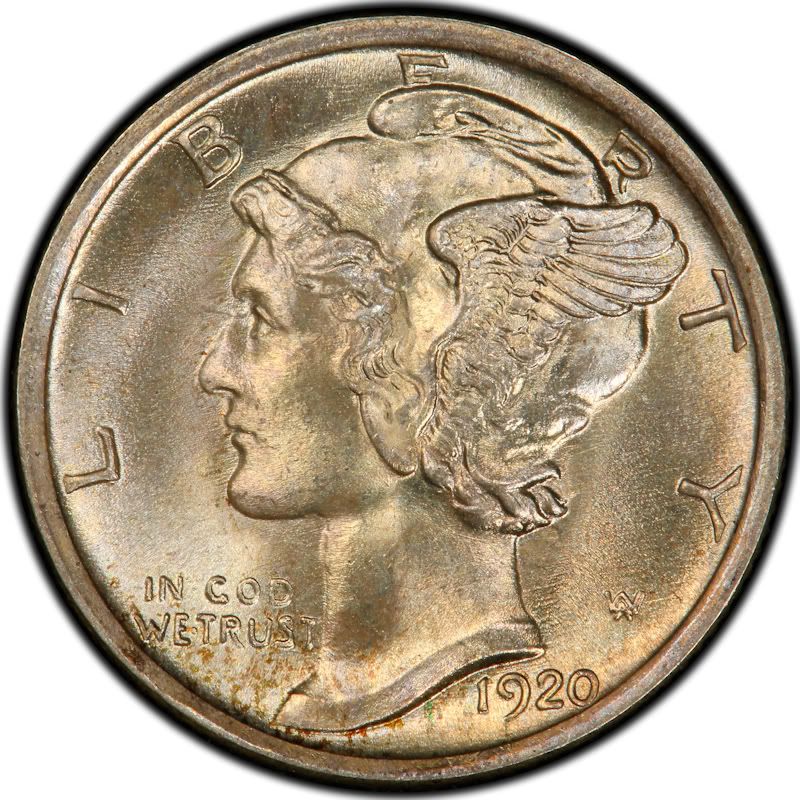
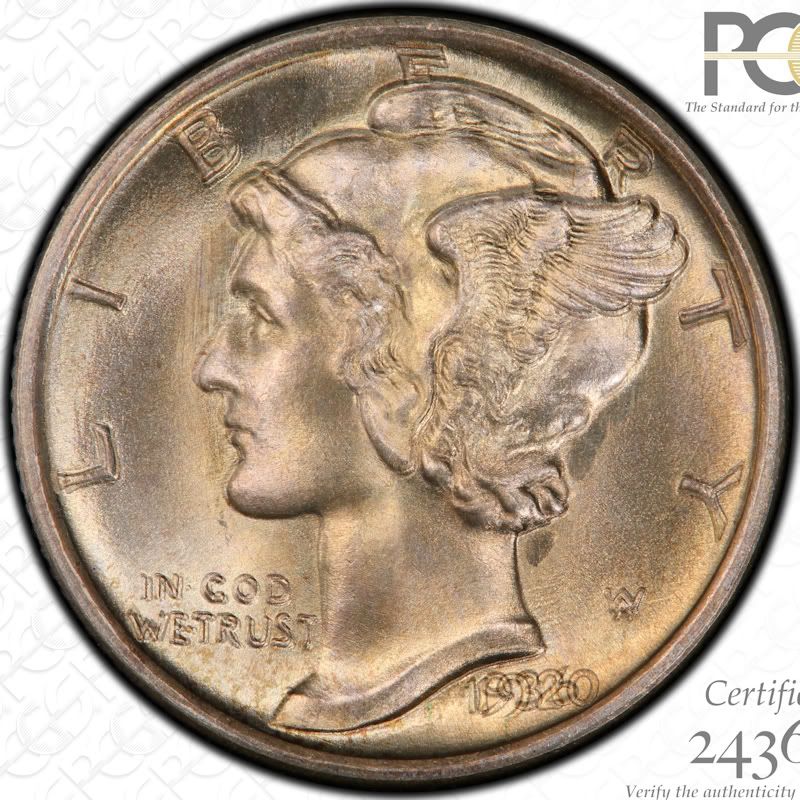
1921
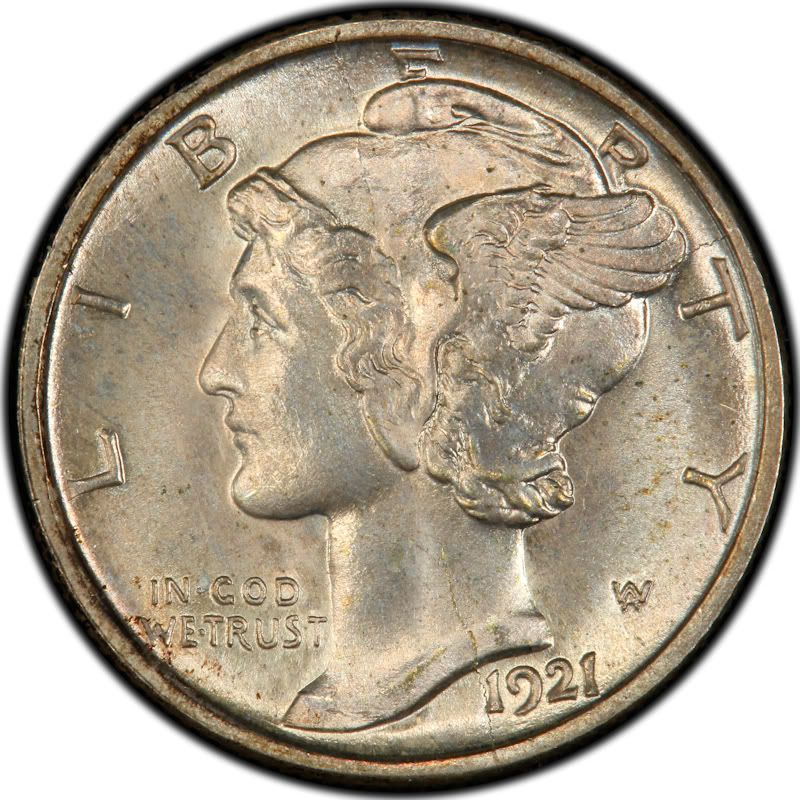
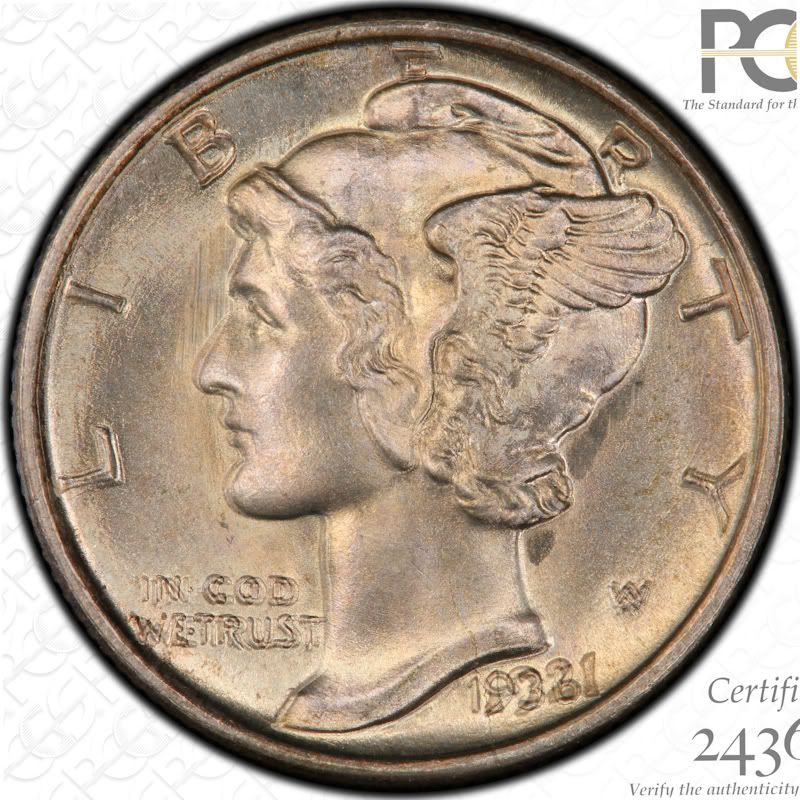
1923
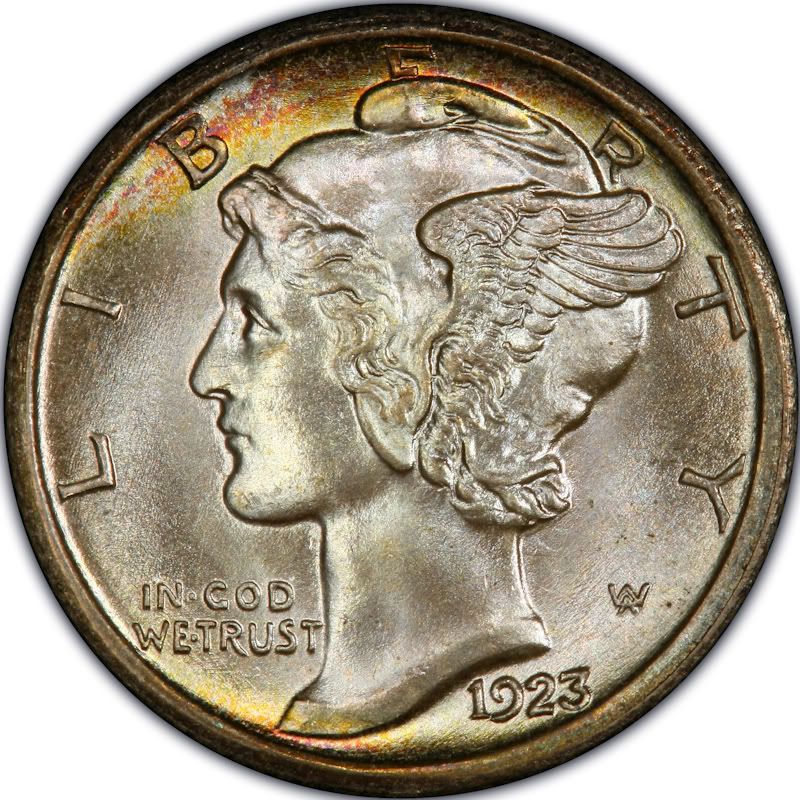
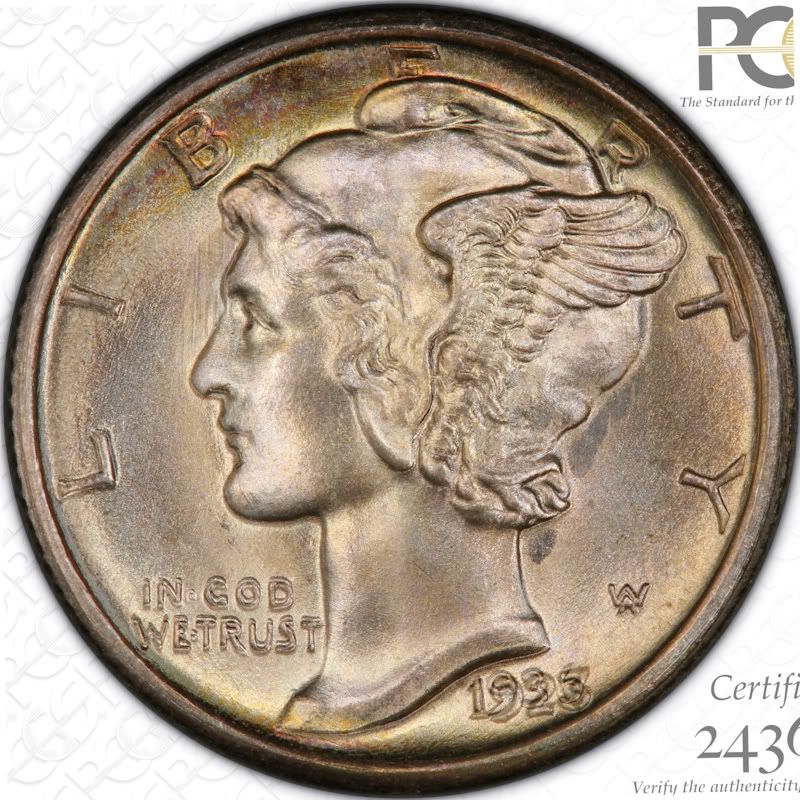
1924
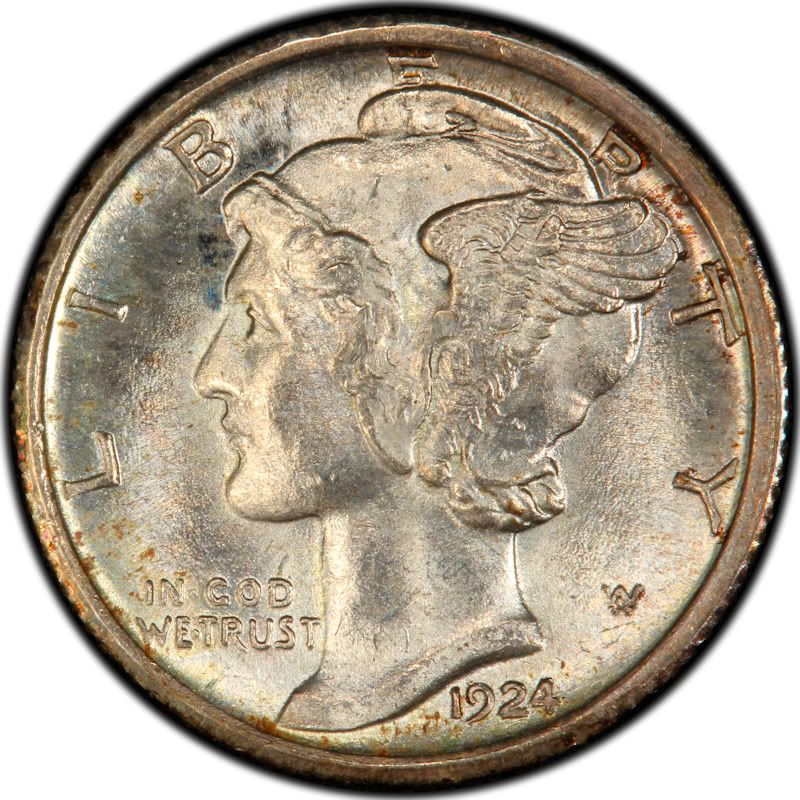
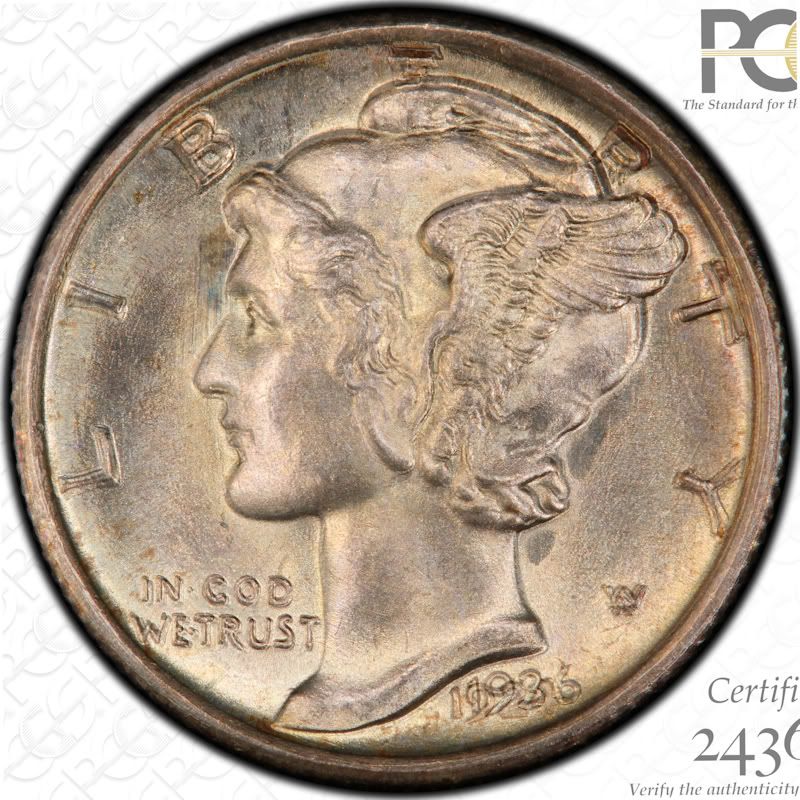
1925
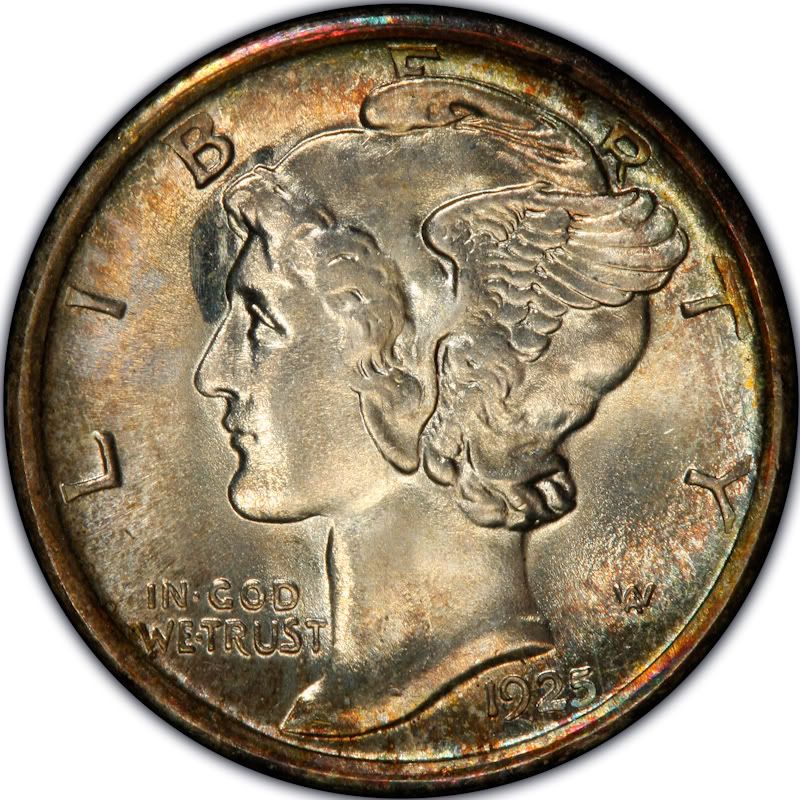
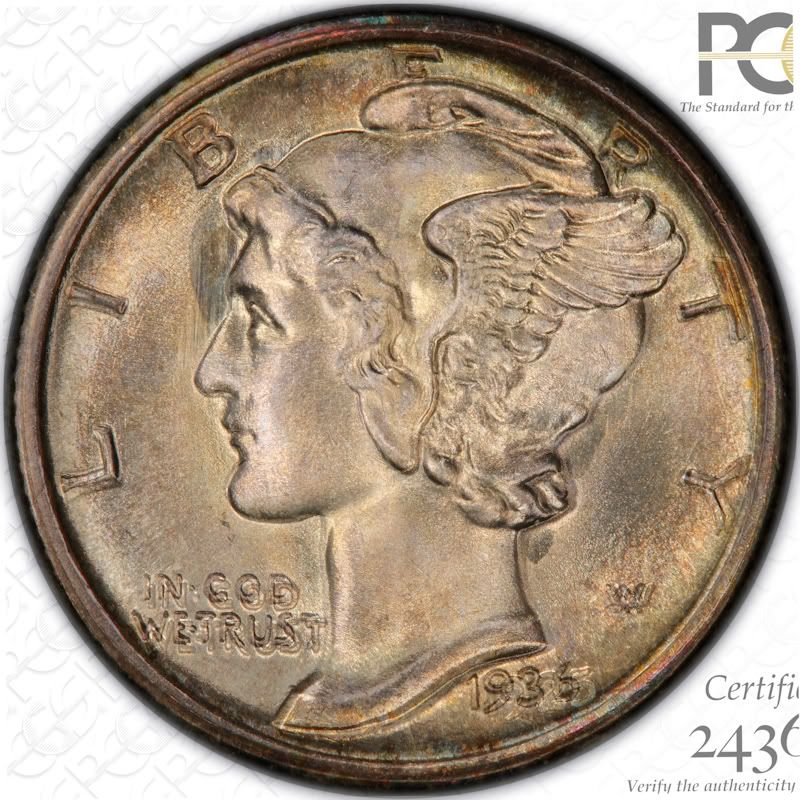
1926
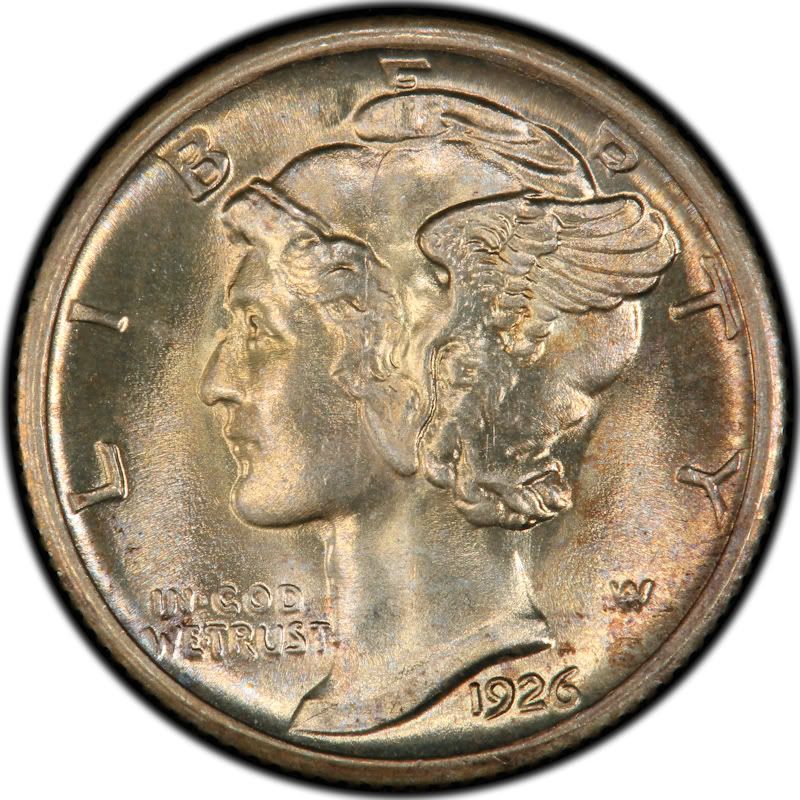
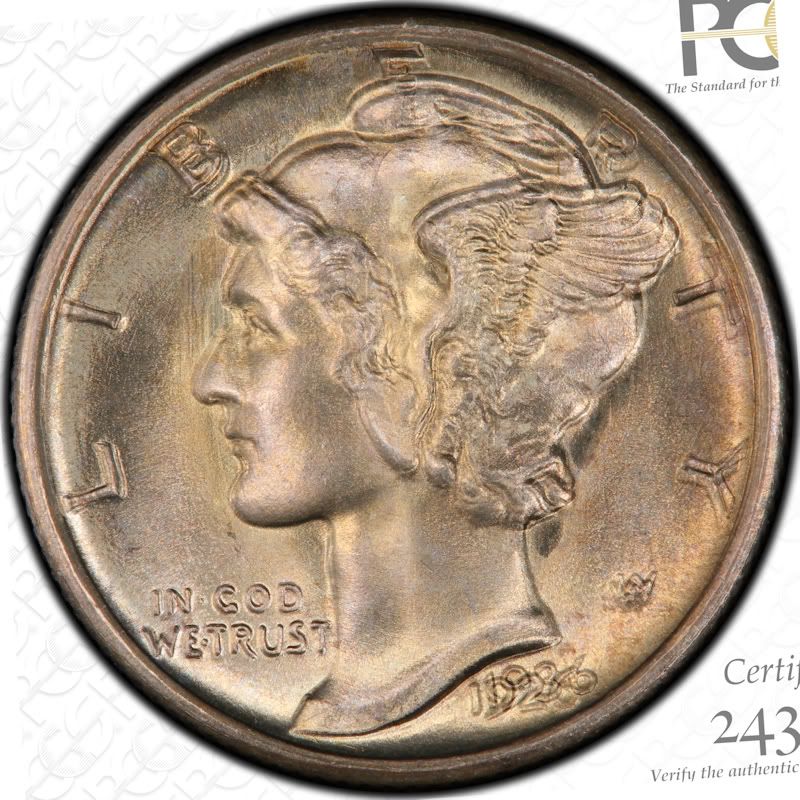
1927
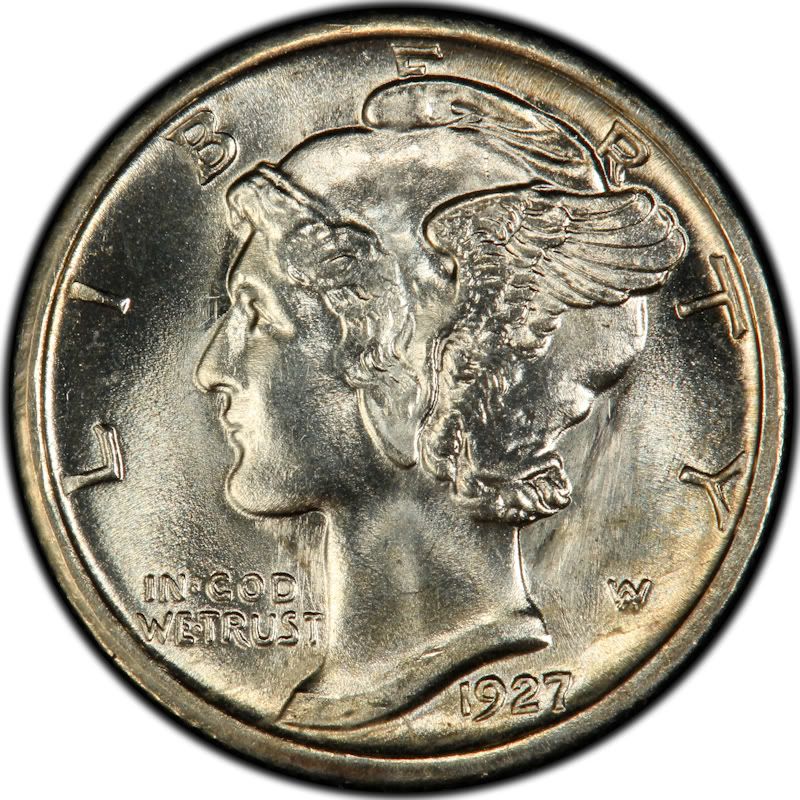
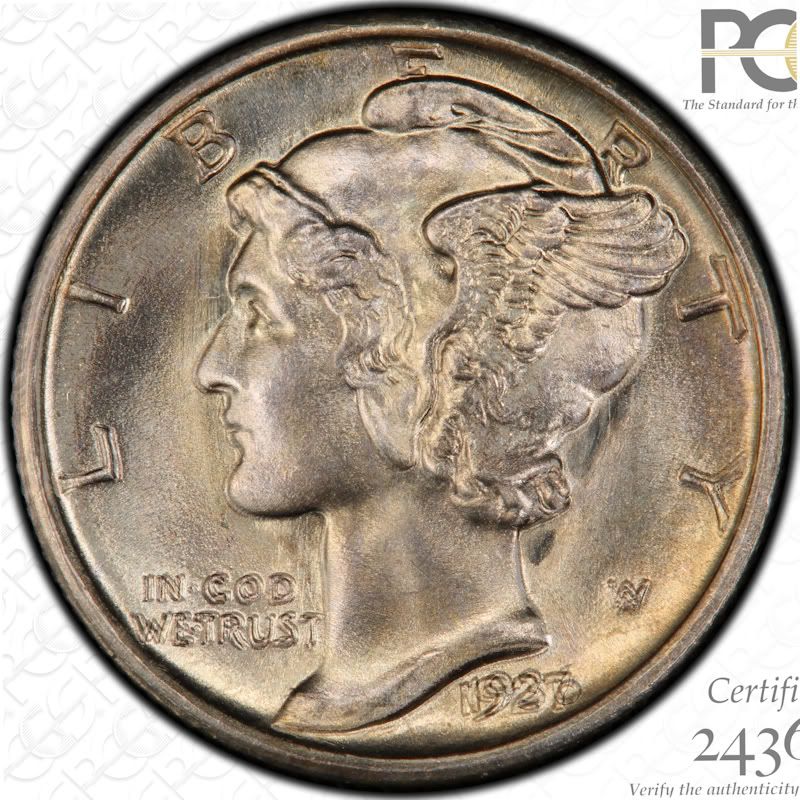
1928
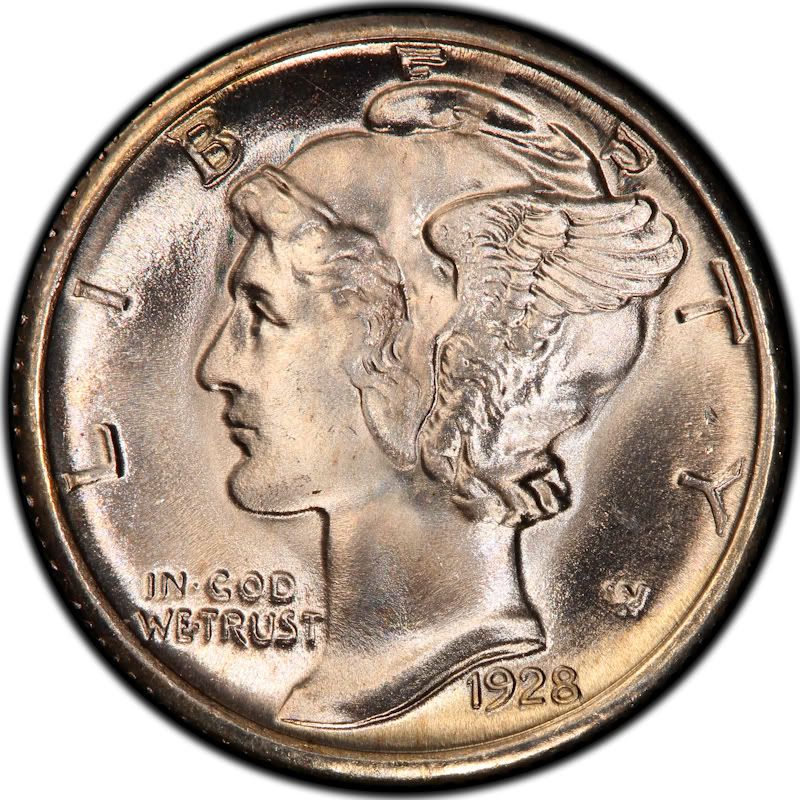
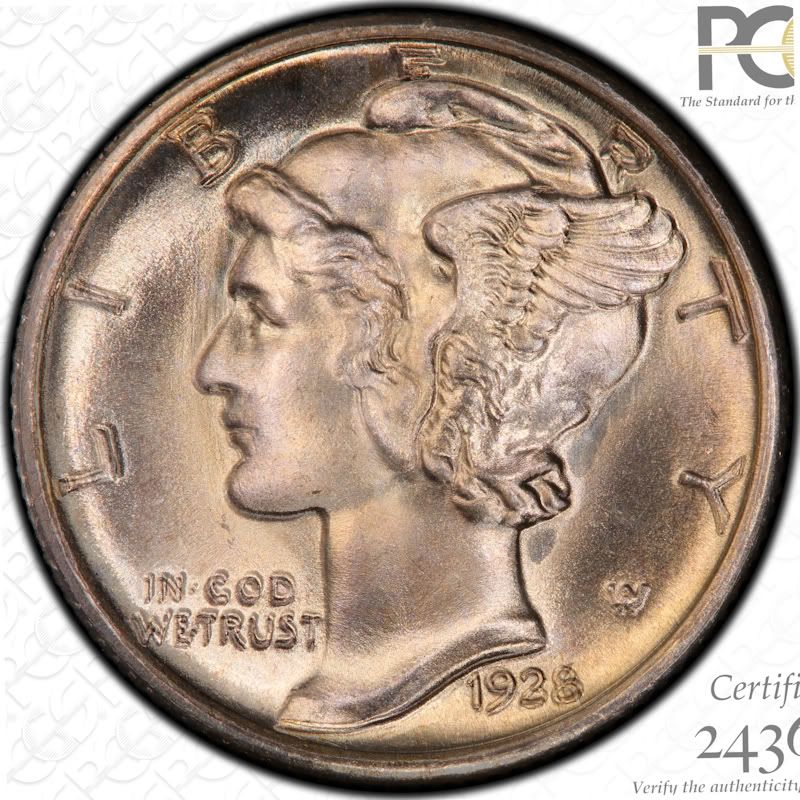
1929
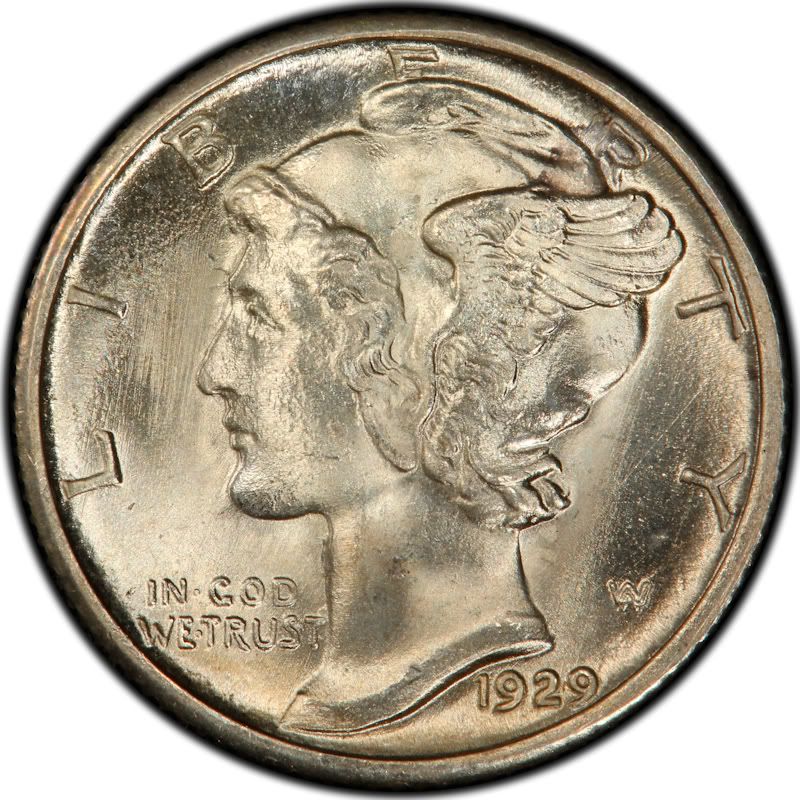
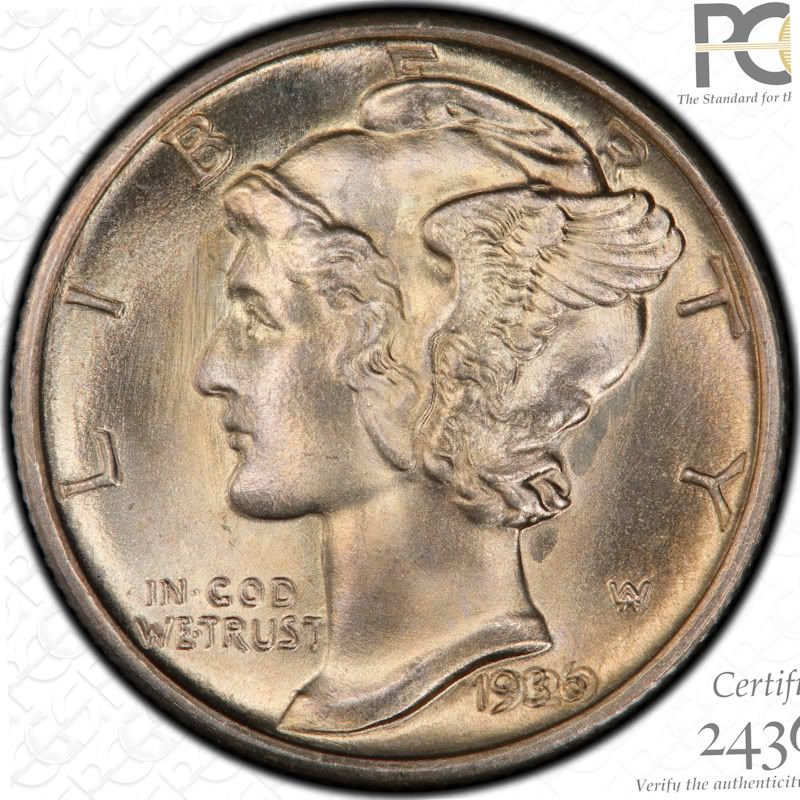
1936
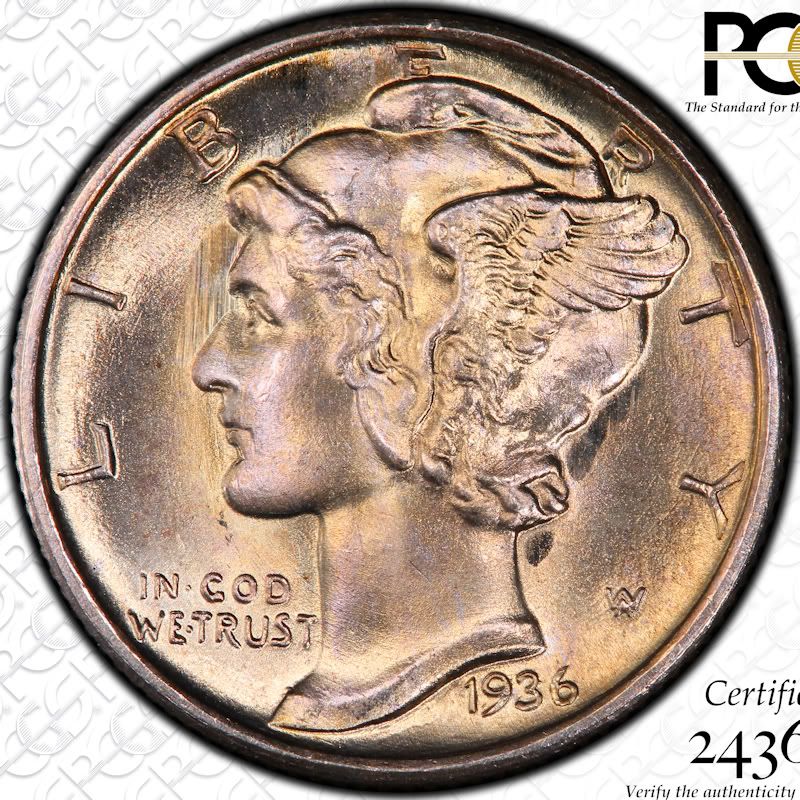
Examination of number style was also done using the PCGS images. The 1929 dime has a much more round upper loop of the 9 as well as a blunt tail; both of these characteristics are different than the 1936 coin, which would mean that those digits might leave evidence. The years 1920 through 1927 also have either a blunt 1 as opposed to the 1 with an upper flag seen on the 1936, an open loop 9 instead of the closed loop 9 on the 1936 and/or a thicker 9 than the 1936. However, the 1928 date is done in the same style as the 1936, which might make it easier to hide the 1928 than any other date in the 1920s. Number style consistency within a year was also looked at by inspecting all the PCGS images listed for each issue in CoinFacts. All dimes within any given year had consistent number styles. The following numbers of coins were looked at in this case-
1920; 5
1921; 17
1923; 10
1924; 8
1925; 15
1926; 12
1927; 3
1928; 10
1929; 12
There has been some previous suggestion that perhaps the numbers within 1929 have been moved slightly to better fit the 1936. If we ignore US Mint procedure at the time of production and instead concentrate to test if this might be at all feasible; the width of the date was measured for the highest six graded 1929-S dimes. The width was measured in two ways to control for any possible rotation of the images. The first measurement was taken as a horizontal from the leftmost tip of the upper flag of the 1 in the date to the farthest point of the 9. The second measurement was taken after the tops of the digits were aligned horizontally and again it was taken as a horizontal from the leftmost tip of the upper flag of the 1 in the date to the farthest point of the 9. The measurements from the six 1929 coins were compared to the subject 1936 coin where the 1936 was measured from the leftmost tip of the upper flag of the 1 in the date to the outermost part of the lower loop of the 6. An example of the measurement (width is blue line) and results are below, expressed as pixel width before rotation correction and after rotation correction (before/after)-
1929 without orientation correction
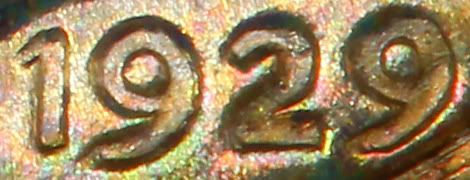
1929 with orientation correction and thin blue line showing measurement
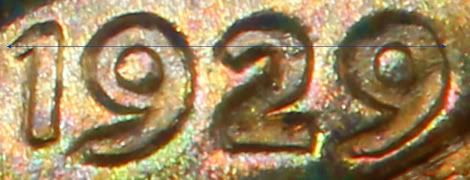
1936 without orientation correction
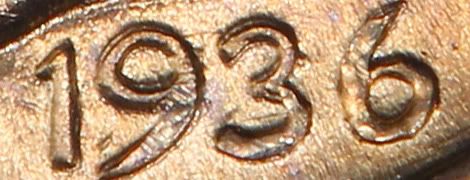
1936 with orientation correction and thin blue line showing measurement
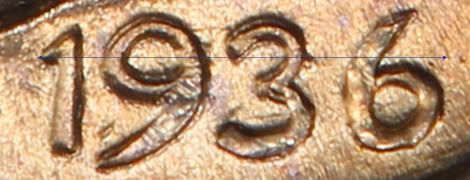
Pixel width of date for PCGS imaged 1929 dimes
1929 A; 441/433
1929 B; 438/433
1929 C; 447/447
1929 D; 444/442
1929 E; 449/446
1929 F; 448/440
1936; 400/402
The average pixel width for the 1929 is 444.5 with a standard deviation of 4.3 and 440.2 with a standard deviation of 6.1 when corrected for rotation. These numbers are far larger than what is found for the 1936 coin and support the notion that numeral placement variability would not be a factor to support the 1936/1929 or 36/29 overdate.
If we then examine an overlay of the date only, without a global view of the coin, we can see the date-specific spacing of a given pair of years. This is not a realistic overlay in that we are now ignoring the bulk of the coin and are moving the date independent of the remainder of the obverse, but it may give insight into how well different dates can be made to sit on one another. The leftmost portion of the first 1 in the date was used as the point where the two dates should overlap. Overlays of the 1936 placed on top of dimes from 1926-1929 appear to rule out the 1929 as a possible candidate, but do not rule out entirely the 1926 through 1928 issues, see below-
1936/1926
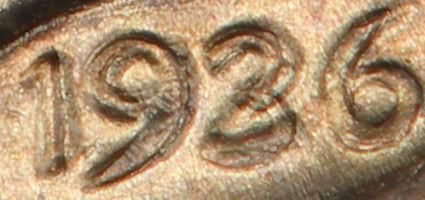
1936/1927
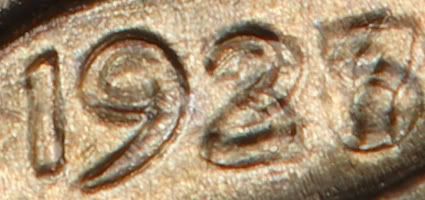
1936/1928
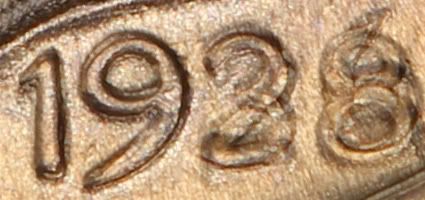
1936/1929
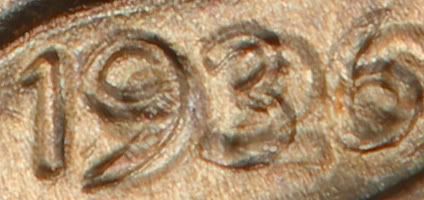
Overall, it seems from the tests performed on the data available there is little evidence to support a 1936/1929 or 36/29 overdate. However, dimes from 1926-1928 have some possibility of being candidates for an overdate based upon a date-specific overlay. Further, only the 1928 dime appears to be a credible underdate candidate based upon a global overlay, which may be the most realistic method used in these tests. Lastly, the numeral style of the 1928 issues matches best with the 1936 issue. Examination of the what might be, and is claimed to be, the vertex of the 2 within the lower loop of the 3 of 1936 with respect to placement and size for the 1928 issue will be critical in being able to more definitively exclude this candidate or to embrace it or another as being at all possible or even the likely underdate. At this time I have not performed this analysis, but others are welcome to do it, too, as well as to contribute constructive criticism or other data. Alternative explanations for this coin still include fortuitous die gouges or marks as well as a single, inappropriate underdigit (2) punched in and then partially corrected during preparation of the 1936 die. Lastly, it is my opinion that PCGS and others did the collecting community no favor by designating this coin as a 1936/1929 or 36/29 given the data examined to this point. There may be a 2 underneath the 3, but the last digit does not show any conclusive evidence of being over another, previous digit. If the coin were simply labeled as 1936-S (3/2) or 1936-S (die gouges near date) then it may not have been received the same way by many folks.
There has been some discussion and quite a bit of digging heels in the sand on the boards this past week regarding this possible overdate. To be upfront with all, I never thought I would be writing a thread about an overdate or possible overdate Mercury dime. In general, I find some overdates, doubled dies, die marriages and the like interesting while the majority do not move me one way or another. The overdates that have caught my attention are the 1805/4 DBH and 1817/3 CBH, the doubled dies would be the 1934 WQ DDO, 1955 Lincoln DDO and 1972 Lincoln DDO while the die marriages have more to do with early Federal coinage quirks than anything else. Regardless, I find myself here tonight writing about a possible overdate in the Mercury dime series.
The reason for this thread stems from the latest discussion of this coin here in combination with previous discussions in June, 2010 here and November, 2010 here. If these discussions had stayed on topic and not strayed into some hypothesizing as to personal motivations then I highly doubt I would be moved to write about this coin. After all, I have little interest in the Mercury dime series (aside from the coin as a type coin) and even less interest in most named die varieties.
In this thread, this coin has been approached as I would approach any scientific problem in any lab that I have had over the years, regardless of if the lab were in a hospital-based academic setting, a chemical quality control industrial setting, a research and development pharmaceutical setting or a biotech setting. I have attempted to go about identifying the problem or question, assessing what tools I have at my disposal, examining the data and then coming to likely conclusions. There is no doubt in my mind that whatever conclusion might be reached on my part that some will not agree. That is okay, but it helps if those who do not agree can point out the errors of my ways, can add more valid data or can give a plausible explanation that runs counter to this interpretation. In other words; I don’t have to be correct and, in fact, within science it is quite common for interpretations or likely possibilities to be wrong. Additionally, it is accepted practice for most data to be shared and for those who provide the data to explain why they made the choices that were made. Therefore, this thread might be even less reader-friendly than a typical thread that I might produce and for that I apologize, but hope all understand my goal.
In the June, 2010 thread, which was titled “Pick on this for me”, I admitted that I could not see a 1936/1929 or 36/29 overdate and at the same time offered that it might be a series of fortuitously placed die gouges. The explanations given to the contrary did not match what I thought likely or what I could see in images, but I was not too concerned about the coin. I felt comfortable questioning the coin given the title of the thread. The second thread had little input from me except when it was written that some who might not believe the 1936/1929 or 36/29 overdate explanation might be doing so out of some sort of ego driven reason. During that discussion I asked if another forum member, who owns multiple examples of this coin, would be willing to ship to me a high grade example for in-hand inspection and high quality photography. Of course, I would have returned the coin immediately after images were taken. This request was rejected outright and instead images were emailed to me, but the images were not very useful. I proceeded again to not think of the coin until the most recent thread and the statements by certain proponents of the overdate theory as to the motives of at least some of us who do not support the 1936/1929 or 36/29 idea. The most recent thread also asked for discussion, so again I felt freer to engage the topic.
My goals are to find the most likely reason(s) for the marks near the date on this coin as well as to reject anything that cannot be supported by evidence. Aside from that I do not care about the topic and if it turns out that the data at my disposal suggest a true 1936/1929 or 36/29 overdate then I will state my conclusions as such. In order to best interpret this coin I again mentioned that I had requested an in-hand inspection of the piece, but again the owner of the coin did not volunteer to go along with the offer. Please note that I cannot find too much fault in the refusal to ship the coin since even with Registered Mail there are losses from time-to-time and a loss of a dearly held coin is especially painful. However, the owner did supply the PCGS images of the coin and this is a wonderful thing to have for analysis. The PCGS images allow the following-
1) Examination of multiple examples of the same date/mintmark combination via the archived PCGS images held on the CoinFacts site.
2) Generally exceptional quality images.
3) Uniformity of images that greatly exceeds what would otherwise be available if images were taken from multiple sources.
4) Photography of the coin before encapsulation.
5) Large file sizes that allow significant magnification of the desired area.
6) A lower rate of bias with respect to those coins that might be chosen for this examination.
7) Consistent size of images.
Unfortunately, use of the PCGS images also entails the below-
1) Images instead of coins in-hand.
2) Images that generally highlight strong luster, which might be a liability for any given coin.
3) Only those coins submitted to PCGS for their service are available, so the pool is not uniform.
4) PCGS images have a shadow placed around them that can make certain measurements more difficult.
A global analysis of the placement of the date for each S-mint Mercury dime issue from the 1920s was chosen because of what appears to possibly be the vertex of a 2 within the lower loop of the 3 in the possible overdate. For the 1921 issue, which had no S-mint dimes, a D-mint dime was used instead. The S-mints were chosen in the event that the different mints produced coins of consistent characteristics within the mint and if these characteristics were different from mint-to-mint. Hopefully, this would reduce strike affects from year-to-year. The global analysis was done by placing the entire obverse of the subject 1936 dime over a high grade dime from each date in the 1920s. The coin from the 1920s was chosen to be the highest grade in CoinFacts as long as that coin was not heavily toned. Heavy toning might make the interpretation more difficult so white dimes were best in this case. Not all of the coins imaged by PCGS are imaged in the exact same orientation so a second overlay had to be performed after the 1936 subject dime was rotated in Corel Paint Shop Pro Photo X2. Alignment between the two coins of the letters in LIBERTY as best as possible served as the control for proper global orientation. This global analysis appears to disqualify as a likely candidate all dimes except for 1928 while 1927 might be a possibility, too. See the images below, which in this case are shown as paired images of the possible underdate coin above the overlay-
1920


1921


1923


1924


1925


1926


1927


1928


1929


1936

Examination of number style was also done using the PCGS images. The 1929 dime has a much more round upper loop of the 9 as well as a blunt tail; both of these characteristics are different than the 1936 coin, which would mean that those digits might leave evidence. The years 1920 through 1927 also have either a blunt 1 as opposed to the 1 with an upper flag seen on the 1936, an open loop 9 instead of the closed loop 9 on the 1936 and/or a thicker 9 than the 1936. However, the 1928 date is done in the same style as the 1936, which might make it easier to hide the 1928 than any other date in the 1920s. Number style consistency within a year was also looked at by inspecting all the PCGS images listed for each issue in CoinFacts. All dimes within any given year had consistent number styles. The following numbers of coins were looked at in this case-
1920; 5
1921; 17
1923; 10
1924; 8
1925; 15
1926; 12
1927; 3
1928; 10
1929; 12
There has been some previous suggestion that perhaps the numbers within 1929 have been moved slightly to better fit the 1936. If we ignore US Mint procedure at the time of production and instead concentrate to test if this might be at all feasible; the width of the date was measured for the highest six graded 1929-S dimes. The width was measured in two ways to control for any possible rotation of the images. The first measurement was taken as a horizontal from the leftmost tip of the upper flag of the 1 in the date to the farthest point of the 9. The second measurement was taken after the tops of the digits were aligned horizontally and again it was taken as a horizontal from the leftmost tip of the upper flag of the 1 in the date to the farthest point of the 9. The measurements from the six 1929 coins were compared to the subject 1936 coin where the 1936 was measured from the leftmost tip of the upper flag of the 1 in the date to the outermost part of the lower loop of the 6. An example of the measurement (width is blue line) and results are below, expressed as pixel width before rotation correction and after rotation correction (before/after)-
1929 without orientation correction

1929 with orientation correction and thin blue line showing measurement

1936 without orientation correction

1936 with orientation correction and thin blue line showing measurement

Pixel width of date for PCGS imaged 1929 dimes
1929 A; 441/433
1929 B; 438/433
1929 C; 447/447
1929 D; 444/442
1929 E; 449/446
1929 F; 448/440
1936; 400/402
The average pixel width for the 1929 is 444.5 with a standard deviation of 4.3 and 440.2 with a standard deviation of 6.1 when corrected for rotation. These numbers are far larger than what is found for the 1936 coin and support the notion that numeral placement variability would not be a factor to support the 1936/1929 or 36/29 overdate.
If we then examine an overlay of the date only, without a global view of the coin, we can see the date-specific spacing of a given pair of years. This is not a realistic overlay in that we are now ignoring the bulk of the coin and are moving the date independent of the remainder of the obverse, but it may give insight into how well different dates can be made to sit on one another. The leftmost portion of the first 1 in the date was used as the point where the two dates should overlap. Overlays of the 1936 placed on top of dimes from 1926-1929 appear to rule out the 1929 as a possible candidate, but do not rule out entirely the 1926 through 1928 issues, see below-
1936/1926

1936/1927

1936/1928

1936/1929

Overall, it seems from the tests performed on the data available there is little evidence to support a 1936/1929 or 36/29 overdate. However, dimes from 1926-1928 have some possibility of being candidates for an overdate based upon a date-specific overlay. Further, only the 1928 dime appears to be a credible underdate candidate based upon a global overlay, which may be the most realistic method used in these tests. Lastly, the numeral style of the 1928 issues matches best with the 1936 issue. Examination of the what might be, and is claimed to be, the vertex of the 2 within the lower loop of the 3 of 1936 with respect to placement and size for the 1928 issue will be critical in being able to more definitively exclude this candidate or to embrace it or another as being at all possible or even the likely underdate. At this time I have not performed this analysis, but others are welcome to do it, too, as well as to contribute constructive criticism or other data. Alternative explanations for this coin still include fortuitous die gouges or marks as well as a single, inappropriate underdigit (2) punched in and then partially corrected during preparation of the 1936 die. Lastly, it is my opinion that PCGS and others did the collecting community no favor by designating this coin as a 1936/1929 or 36/29 given the data examined to this point. There may be a 2 underneath the 3, but the last digit does not show any conclusive evidence of being over another, previous digit. If the coin were simply labeled as 1936-S (3/2) or 1936-S (die gouges near date) then it may not have been received the same way by many folks.
0
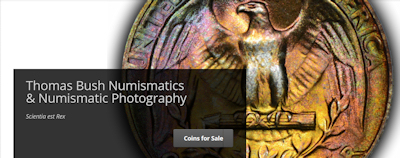
Comments
Bob
Now, if this were about a colonial coin, I would have read every word and wanted more. But since it's about a Mercury Dime, can I get the executive summary?
But doesn't the whole "best fit" analysis break down when you consider the die gouges that do not conform to the overdate overlays? I'm thinking of the largest die gouge, which appears to the left of the "1". Perhaps there are others too.
So -- to shoehorn in an under-date theory, one would have to say: "Yes there is an under-date, but there are also some die gouges near the date as well, which don't correspond to anything. Those are just big die gouges. Ignore them."
I think Occum's Razor would come into play here at some point.
Coin Rarities Online
"When you see hoofprints, think horses; not zebras"
My personal opinion is that there are two most likely causes for the appearance of this coin and they are the presence of die gouges/marks or an inappropriately punched and incompletely removed 2 digit into a new, freshly prepared 1936 die.
In honor of the memory of Cpl. Michael E. Thompson
B. It did not really matter which mint the imaged coins came from, since at that time all dies were made at the Philadephia Mint from the same hubs.
C. Dave Wnuck makes the telling argument that the die has many random die gouges on it, that simply cannot be part of any of the potential underdates as identified by TomB's work. It is illogical to accept the marks that support your argument while rejecting out of the other side of your mouth the marks that destroy your argument.
TD
<< <i> Occum's Razor may definitely apply, as does something I have said many times in research labs and that works well in North America where we have few, if any, zebras-
"When you see hoofprints, think horses; not zebras"
>>
An excellent point!
A Possible 1936-S over 1928 or 1936-S over 2 still seems to still be alive with this analysis...at least that is what I get from it.
To CaptHenway, thank you for pointing out (B)! I was not sure about that and it was an important question that I posed in another thread.
Looking for Top Pop Mercury Dime Varieties & High Grade Mercury Dime Toners.
This is an excellent post and took the OP a ton of time. While I have no dog in this fight, I agree with the following sentence by TomB:
My personal opinion is that there are two most likely causes for the appearance of this coin and they are the presence of die gouges/marks or an inappropriately punched and incompletely removed 2 digit into a new, freshly prepared 1936 die.
Too many positive BST transactions with too many members to list.
Lane
See http://www.doubledimes.com for a free online reference for US twenty-cent pieces
<< <i>This is an excellent post and took the OP a ton of time. While I have no dog in this fight, I agree with the following sentence by TomB:
My personal opinion is that there are two most likely causes for the appearance of this coin and they are the presence of die gouges/marks or an inappropriately punched and incompletely removed 2 digit into a new, freshly prepared 1936 die. >>
Ever look at a high-grade 42/41-D? Same kind of marks can be seen.
I owned the MS-65 example 36-S in one of the original threads. I have also owned a PCGS 58+ 1942/41-D, and there are a lot of similarities in the treatment of the date area.
After doing the initial overlays in this thread (this was my coin being sold, and seanq posted much better overlays) I remain convinced that there is no possible way this can be a 36/29. The '28 was the best candidate as shown in that thread, and Tom's excellent work on this thread backs this up.
I don't think this will ever be agreed on 100%, but I'm in the 'it's possible' crowd, especially since I'm one of the few posters to the original threads that has seen a high-grade example in-hand. Tom- thank you for a very cool thread.
I do have a dog in this fight and to me...that is a TWO under the THREE if I have ever seen one. I would be somewhat inclided to entertain the possibility of die gouges if this thing did not have the same look as the "accepted" 1943/2-P Nickel. It is a TWO under the THREE. To me, it is that simple. The expaination however is clearly not as simple and I really appreciate Tom doing this work and offering up his analysis.
Looking for Top Pop Mercury Dime Varieties & High Grade Mercury Dime Toners.
This topic looks as much fun as the NOT Proof 1895 Morgan from 2006 or so!
Eric
May I suggest that pictures of the subject dime be included in this thread so that others, now and down the road, don't have to bounce around? I realize that they might not share the precision you presented but it would help tidy things up.
Lance.
A closeup of the date follows-
Again, thank you all for the well thought out posts. This makes the thread far better than I originally wrote.
In honor of the memory of Cpl. Michael E. Thompson
<< <i>
This very image is on PCGSCoinfacts.com but without the background.
I would have liked more images of the other 10 coins for this particular coin since that die abrasion in front of Liberty's face and behind the cap may offer some clues as to the dies origin.
The large image reveals circular die scratches as well which are clearly visible on the neck. This tells me that this particular die had some serious work done to it.
The name is LEE!
<< <i>
I would have liked more images of the other 3 coins for this particular coin number since that die abrasion in front of Liberty's face and behind the cap may offer some clues as to the dies origin.
The large image reveals circular die scratches as well which are clearly visible on the neck. This tells me that this particular die had some serious work done to it. >>
The one I sold had the same- it might be the coin pictured, though, as the buyer might have had it true-viewed.
<< <i>
<< <i>
I would have liked more images of the other 3 coins for this particular coin number since that die abrasion in front of Liberty's face and behind the cap may offer some clues as to the dies origin.
The large image reveals circular die scratches as well which are clearly visible on the neck. This tells me that this particular die had some serious work done to it. >>
The one I sold had the same- it might be the coin pictured, though, as the buyer might have had it true-viewed. >>
Christian, that one is not mine. The one pictured is MS66FB. Mine is MS65FB, with many of the same characteristics. I have posted it in the other recent threads. I am away from home but can post it later in this thread.
Looking for Top Pop Mercury Dime Varieties & High Grade Mercury Dime Toners.
<< <i>I agree with you completely, Dave. This was not meant to be an exhaustive, definitive analysis of the coin especially since I have only had the images since Friday night. Rather, this was meant to be a more analytical inspection of the coin than I have seen to this point. Occum's Razor may definitely apply, as does something I have said many times in research labs and that works well in North America where we have few, if any, zebras-
"When you see hoofprints, think horses; not zebras"
My personal opinion is that there are two most likely causes for the appearance of this coin and they are the presence of die gouges/marks or an inappropriately punched and incompletely removed 2 digit into a new, freshly prepared 1936 die. >>
To the best of my knowledge, the last time that the Philadelphia Mint used a numeral punch on a U.S. coin die was in 1908. What could this alleged 2 have been punched with?
<< <i>
<< <i>I agree with you completely, Dave. This was not meant to be an exhaustive, definitive analysis of the coin especially since I have only had the images since Friday night. Rather, this was meant to be a more analytical inspection of the coin than I have seen to this point. Occum's Razor may definitely apply, as does something I have said many times in research labs and that works well in North America where we have few, if any, zebras-
"When you see hoofprints, think horses; not zebras"
My personal opinion is that there are two most likely causes for the appearance of this coin and they are the presence of die gouges/marks or an inappropriately punched and incompletely removed 2 digit into a new, freshly prepared 1936 die. >>
To the best of my knowledge, the last time that the Philadelphia Mint used a numeral punch on a U.S. coin die was in 1908. What could this alleged 2 have been punched with? >>
Didn't John Wexler speculate that the Mint prepared master hubs in the 1930s without the last digit? He had identified a few coins from the mid 1930s which he claimed showed a repunched or re-engraved final digit. I don't know if anyone else in the hobby corroborated his theory. You COULD take a nice long leap of logic and say that this could be an unfinished master die from the late 1920s which was reused as a working die in 1936. It would also explain why there is no evidence of an underdate near the 6.
Sean Reynolds
P.S.: I should also thank Tom for producing all of those overlays. The 1936/28 that I made used seems to align better with this variety than the one you made, possibly because I used multiple design elements to align them.
"Keep in mind that most of what passes as numismatic information is no more than tested opinion at best, and marketing blather at worst. However, I try to choose my words carefully, since I know that you guys are always watching." - Joe O'Connor
Looking for Top Pop Mercury Dime Varieties & High Grade Mercury Dime Toners.
Thank you for taking the time and effort to go through this.
I have personally handled several of these coins ranging from VF to MS66FB. Of the group the one you used in this thread is about the third best one for detail in which I have handled for detail. The coin bolivarshagnasty started the other thread about was the second best detailed coin I have looked at.
The coin I have with the best detail is in a Genuine holder. Someone had cleaned the coin, so it is designated as such. (Can I scream here, do not clean coins!)
Both coins in the Coin Facts images are my coins.
Tony
President, Racine Numismatic Society 2013-2014; Variety Resource Dimes; See 6/8/12 CDN for my article on Winged Liberty Dimes; Ebay
Now, what is your take on the authenticity of the 1914/3 Buffalo Nickel?
Garrow
<< <i>
<< <i>
<< <i>I agree with you completely, Dave. This was not meant to be an exhaustive, definitive analysis of the coin especially since I have only had the images since Friday night. Rather, this was meant to be a more analytical inspection of the coin than I have seen to this point. Occum's Razor may definitely apply, as does something I have said many times in research labs and that works well in North America where we have few, if any, zebras-
"When you see hoofprints, think horses; not zebras"
My personal opinion is that there are two most likely causes for the appearance of this coin and they are the presence of die gouges/marks or an inappropriately punched and incompletely removed 2 digit into a new, freshly prepared 1936 die. >>
To the best of my knowledge, the last time that the Philadelphia Mint used a numeral punch on a U.S. coin die was in 1908. What could this alleged 2 have been punched with? >>
Didn't John Wexler speculate that the Mint prepared master hubs in the 1930s without the last digit? He had identified a few coins from the mid 1930s which he claimed showed a repunched or re-engraved final digit. I don't know if anyone else in the hobby corroborated his theory. You COULD take a nice long leap of logic and say that this could be an unfinished master die from the late 1920s which was reused as a working die in 1936. It would also explain why there is no evidence of an underdate near the 6.
Sean Reynolds
P.S.: I should also thank Tom for producing all of those overlays. The 1936/28 that I made used seems to align better with this variety than the one you made, possibly because I used multiple design elements to align them. >>
That would be an extreme leap of logic, indeed!
I too am curious when in the process an errant 2 punch could have been introduced, but we
all know that strange things have occurred at the mint.
A 3/2 does appear to be the only plausible option here and I hope this is determined definitively one way or the other.
In the meantime, this sure is an interesting coin and I love interesting coins.
Kudos Tom.
Tom, i think what you stated above in the first linked thread is probably the best "analysis" in the least number of words offered.
<< <i>Awesome job Tom in detailing your thought process.
I too am curious when in the process an errant 2 punch could have been introduced, but we
all know that strange things have occurred at the mint.
A 3/2 does appear to be the only plausible option here and I hope this is determined definitively one way or the other.
In the meantime, this sure is an interesting coin and I love interesting coins.
Kudos Tom. >>
Actually, the theory that the marks are the result of random die marks is the far more plausible option.
Here's a thought....everybody look at their BU S-mint dimes from 1935, 1936 and 1937 to get an idea of how common random die marks are at this mint in this era.
President, Racine Numismatic Society 2013-2014; Variety Resource Dimes; See 6/8/12 CDN for my article on Winged Liberty Dimes; Ebay
<< <i>
Actually, the theory that the marks are the result of random die marks is the far more plausible option.
Here's a thought....everybody look at their BU S-mint dimes from 1935, 1936 and 1937 to get an idea of how common random die marks are at this mint in this era. >>
And the 2 under the 3 looks the same as the 1943/2 Jefferson...
That is strange that stray DIE MARKS create possible over dates on different coins that look the exact same from a different series.
Looking for Top Pop Mercury Dime Varieties & High Grade Mercury Dime Toners.
I'm in the camp that believes that these are likely die scratches/gouges/anomalies, but bolivar's mention of the Lincoln obverse design varieties is rather interesting. I would think it suggests that in 1936 they may have been reusing master dies or some other other hubs/dies that were last used in 1929. Perhaps more fuel for those who want to believe that a working die was reused.
Whatever your position, it is a pretty fun coin. Beats the heck out of most VAMs, and I find it much more interesting than the '37-D three-legged Buffalo.
Thanks, again, Tom!
Ron
CG
YES!!! Don't even go there Realone.
This is a variety......that is a 2 inside the 3......PERIOD!!!!
There should be a "You Suck" award for something like this.
<< <i>There should be a "You Suck" award for something like this. >>
That was something like my thought
<< <i>This is a variety......that is a 2 inside the 3......PERIOD!!!! >>
If it were as obvious as you imply that it's a 2 under the 3 we wouldn't have threads like this with so much disagreement.
I asked in one of the previous threads but didn't get an answer. Are there any other variety experts/catalogers besides the CPG that list this as an overdate/DDO?
Franklin-Lover's Forum
<< <i>
Yes.
The name is LEE!
<< <i>
<< <i>This is a variety......that is a 2 inside the 3......PERIOD!!!! >>
If it were as obvious as you imply that it's a 2 under the 3 we wouldn't have threads like this with so much disagreement.
I asked in one of the previous threads but didn't get an answer. Are there any other variety experts/catalogers besides the CPG that list this as an overdate/DDO? >>
There is no DOUBLING (DDO) anywhere on the coin that I am aware of.
There is no CONECA number for it as far as I know.
There is no reference to the variety in David Lange's 2005 Book: "The Complete Guide to Mercury Dimes 2nd Edition"
There is no reference to the variety in John A. Wexler & Kevin Flynn's 2005 book: Treasure Hunting Mercury Dimes
I do not think this variety was known back in 2005...maybe someone else can let us know when it was discovered? Bill Fivaz is the discoverer I believe.
Anyone have contact information for David Lange, John A. Wexler, Kevin Flynn, Bill Fivaz, JT Stanton, James Wiles, Larry Briggs, Bill VanNote, Bill Afanato, John Bordner, Sam Lukes, Ron Pope, John Gillian, Joe Ridzy, Joseph Amoroso, Robert Lawson, Brian Raines, Frank Doty Jr etc................................and the long list of folks acknowledged in the CPG? I have a couple of email addresses for a couple of these folks, somewhere....I would have to track them down.
It sure would be interesting to bring some of these fine folks into the discussion to see what they have to say. Let's reach out to these folks, let's get it re-classified as 3 over 2...of the 1928 type....or whatever....or the possibility that was presented - an inappropriately punched and incompletely removed 2 digit into a new, freshly prepared 1936 die.
I agree, it would be very interesting to see what some of these other experts have to say. Who can reach out to some of these folks in order to pull them into the conversation?
Looking for Top Pop Mercury Dime Varieties & High Grade Mercury Dime Toners.